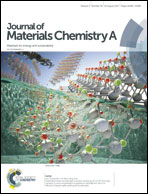Efficient perovskite photovoltaic devices using chemically doped PCDTBT as a hole-transport material†
Abstract
It is shown that by chemically doping the carbazole-based conjugated polymer PCDTBT using the molecular materials TBP, LiTFSI and FK209, its conductivity can be increased by a factor of 105 times. Such doped PCDTBT films are used as a hole transport material (HTM) for standard architecture (CH(NH2)2PbI3)0.85(CH3NH3PbBr3)0.15 perovskite solar cells (PSCs). We show that devices with optimised PCDTBT thickness and doping level achieve a peak power conversion efficiency (PCE) of 15.9%. We expect a number of related doped conjugated polymers to also be capable of acting as efficient HTMs for PSCs.



 Please wait while we load your content...
Please wait while we load your content...